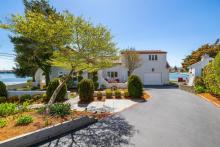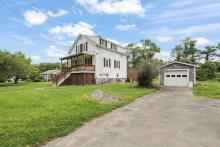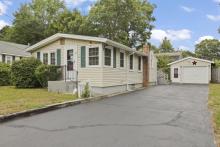Opinion: Marion's failure to pass Article 13 will be costly
To the editor: Article 13 failed to pass at the recent Special Town Meeting. This article required a two/thirds vote to change the zoning on a parcel of land along the Weweantic River to Residence E. This zoning change was to support the plans of a developer to build a 48-unit development on 30 acres called “The Cottages”. It was to be targeted at seniors with, for example, all first-floor master bedrooms.
Residence E permits 12 units per acre. Prior to the town meeting, in good faith, the developer executed a deed restriction limiting the number of units to a maximum of 48 on thirty acres.
This Article was not to approve the actual project, but only to provide the developer the zoning required for the project. He still would have to apply to the Planning Board for a Special Permit and comply with the requirements of the Subdivision Rules and Regulations. This proposed project was in line with the 2017 Master Plan goal of providing more moderate size housing for seniors looking to stay in Marion when they downsize.
One person expressed concern at the town meeting that this proposed new development was not legally restricted to seniors. The developer has not offered to do that, but is that really necessary and is that a reason to vote against a zoning change for this development? For example, what if 20 of the homes are bought as second homes for summer residents? That would be ideal. Summer residents use little or no Town services, less than seniors, but pay the same taxes as the rest of us.
This individual apparently was concerned about the development adding a lot of students to our school system. The Bay Club is not restricted to seniors but ended up being predominantly seniors and empty nesters. When fully built out, it will have 189 dwellings. Of the 145 built to date, they estimate that 37 or 26% have at least one school age child. It is likely that The Cottages, if built, attracts some school age children. We suspect not as many as the Bay Club because the average size of the homes at The Cottages will be about half that of the average home at the Bay Club and thus too small for most families
Residence E zoning requires that all dwellings be connected to the sewer system. Currently, the sewer stops at Point Road and the developer, not the Town of Marion, would have to pay to run the sewer line down the north side of Route 6 to the entrance for this development. Some people living along Route 6 were apprehensive that they might be required to hook into the sewer system. A sewer line will be run down Route 6 eventually and either the developer pays for it now or the properties along Route 6 will be required to pay for it later through betterments. A vote against this zoning change thus was a vote against a sewer line being installed along the north side of Route 6 at no cost to the abutters and the Town.
Running a waste treatment plant is expensive and has a high fixed cost, which means the cost of operating the plant doesn’t go up much when new rate payers are added. Marion currently has only approximately 1,700 rate payers and thus lack economies of scale. In the case of this development, the developer would have paid for all infrastructure improvements to support extending the sewer down Route 6. This would include a substantial payment towards lining our aging sewer pipes and reducing storm water infiltration into the system, freeing up capacity under our discharge permit. We thus would be adding 48 rate payers at little or no cost to the Town.
Another comment was that adding 48 rate payers to our Sewer Enterprise Fund would not impact rates. Not true, doing so would immediately generate $480,000 in sewer hook-up fees and 48 users would mitigate future rate increases. 48 rate payers equal almost 3% of our existing rate base, and thus would increase the revenues of the Sewer Enterprise Fund by approximately 3%. This 3% is the difference between, for example, rates going up 10% versus only 7% after adding these new users.
Real estate taxes also would be a positive. Our current tax rate is $11.32 per thousand of assessed value. Let’s assume the average home at The Cottages ends up being assessed for $650,000. You multiply $650,000 times 48, to arrive at the total assessed value of properties in this development of $31,200,000. This would result in new tax revenues to the Town year one of $353,184. This would be significant new revenue to the Town and help pay some bills, saving existing tax payers money.
People mistakenly think that Proposition 2.5 prevents their taxes from going up more than 2.5%; it does not. In simple terms, the Town is able to raise total tax revenues by 2.5% of the tax revenues for the prior fiscal year. The Town then uses that estimated number for tax revenues and divides it by the total assessed value of properties in Town to determine the tax rate for the fiscal year. Increase the assessed value of properties by new development and the tax rate goes down; decrease the assessed value of properties by taking properties off the tax roll for open space and the tax rate goes up.
A comment was made after the Special Town Meeting that the vote was proof that the Town wants more open space and not new developments. The term “open space” did not come up once in the debate that night. It however is a moot point because the developer paid several million dollars to buy these 30 acres along the Weweantic River and he will build something there. Under current zoning, it is likely he could put up as many as 15 “mega mansions” by right. Wouldn’t the Town be better off with 48 modest size homes, between 1,800 sq. ft. and 2,500 sq. ft., with first floor master bedrooms targeted for seniors?
And, do we really need more open space? The 2017 Master Plan stated that 34% of Marion’s 9,105 acres is already permanently protected and thus pays no real estate taxes. Every time we take properties off the tax rolls to create more open space, it results in the tax rate going up for the properties that remain on the tax rolls. Another 15% of our total acres are temporarily protected under Chapter 61, 61A, and 61B, resulting in little or no taxes. And, Marion also has a significant number of properties such as schools and churches that are tax exempt.
If we continue to shrink our already small tax base, we will become a place such as Edgartown or Nantucket where only the rich can afford to live and we will force moderate- and middle-income residents to move to other towns. Over half our land area thus pays little or no taxes.
We need to be receptive to new growth, which fits the Master Plan of the Town. New growth will add incremental tax revenues and increase the total assessed value of properties in Marion, which, everything else being equal, will keep our tax rate from going up by as much as it would otherwise. And, new growth with sewer connections will help mitigate increases in our sewer rates.
Unfortunately, it may be too late to salvage The Cottages and we may end up with something far less desirable being built on this 30-acre site.












